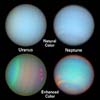| . |  |
. |
Pasadena - Feb 24, 2004 Planetary scientists at the California Institute of Technology and Yale University on Tuesday night discovered a new planetoid in the outer fringes of the solar system. The planetoid, currently known only as 2004 DW, could be even larger than Quaoar--the current record holder in the area known as the Kuiper Belt--and is some 4.4 billion miles from Earth. According to the discoverers, Caltech associate professor of planetary astronomy Mike Brown and his colleagues Chad Trujillo (now at the Gemini North observatory in Hawaii), and David Rabinowitz of Yale University, the planetoid was found as part of the same search program that discovered Quaoar in late 2002. The astronomers use the 48-inch Samuel Oschin Telescope at Palomar Observatory and the recently installed QUEST CCD camera built by a consortium including Yale and the University of Indiana, to systematically study different regions of the sky each night. Unlike Quaoar, the new planetoid hasn't yet been pinpointed on old photographic plates or other images. Because its orbit is therefore not well understood yet, it cannot be given an official name. "So far we only have a one-day orbit," said Brown, explaining that the data covers only a tiny fraction of the orbit the object follows in its more than 300-year trip around the sun. "From that we know only how far away it is and how its orbit is tilted relative to the planets." The tilt that Brown has measured is an astonishingly large 20 degrees, larger even than that of Pluto, which has an orbital inclination of 17 degrees and is an anomaly among the otherwise planar planets. The size of 2004 DW is not yet certain; Brown estimates a size of about 1,400 kilometers, based on a comparison of the planetoid's luminosity with that of Quaoar. Because the distance of the object can already be calculated, its luminosity should be a good indicator of its size relative to Quaoar, provided the two objects have the same albedo, or reflectivity. Quaoar is known to have an albedo of about 10 percent, which is slightly higher than the reflectivity of our own moon. Thus, if the new object is similar, the 1,400-kilometer estimate should hold. If its albedo is lower, then it could actually be somewhat larger; or if higher, smaller. According to Brown, scientists know little about the albedos of objects this large this far away, so the true size is quite uncertain. Researchers could best make size measurements with the Hubble Space Telescope or the newer Spitzer Space Telescope. The continued discovery of massive planetoids on the outer fringe of the solar system is further evidence that objects even farther and even larger are lurking out there. "It's now only a matter of time before something is going to be discovered out there that will change our entire view of the outer solar system," Brown says. The team is working hard to uncover new information about the planetoid, which they will release as it becomes available, Brown adds. Other telescopes will also be used to better characterize the planetoid's features. Related Links SpaceDaily Search SpaceDaily Subscribe To SpaceDaily Express
 Baltimore - Jan 27, 2004
Baltimore - Jan 27, 2004Atmospheric features on Uranus and Neptune are revealed in images taken with the Space Telescope Imaging Spectrograph and the Advanced Camera for Surveys aboard NASA's Hubble Space Telescope. A wider view of Uranus reveals the planet's faint rings and several of its satellites. The observations were taken in August 2003. |
|
| The content herein, unless otherwise known to be public domain, are Copyright 1995-2006 - SpaceDaily.AFP and UPI Wire Stories are copyright Agence France-Presse and United Press International. ESA PortalReports are copyright European Space Agency. All NASA sourced material is public domain. Additionalcopyrights may apply in whole or part to other bona fide parties. Advertising does not imply endorsement,agreement or approval of any opinions, statements or information provided by SpaceDaily on any Web page published or hosted by SpaceDaily. Privacy Statement |